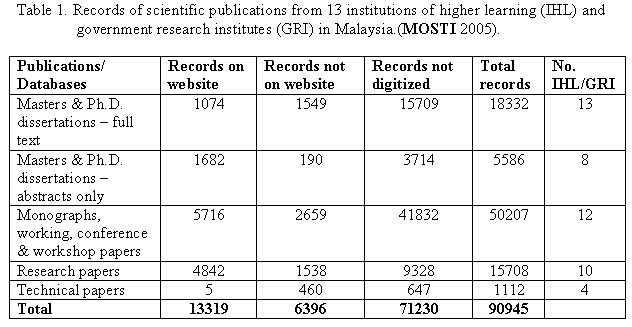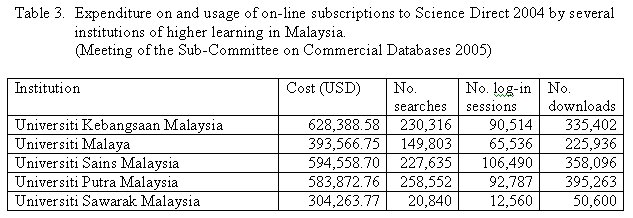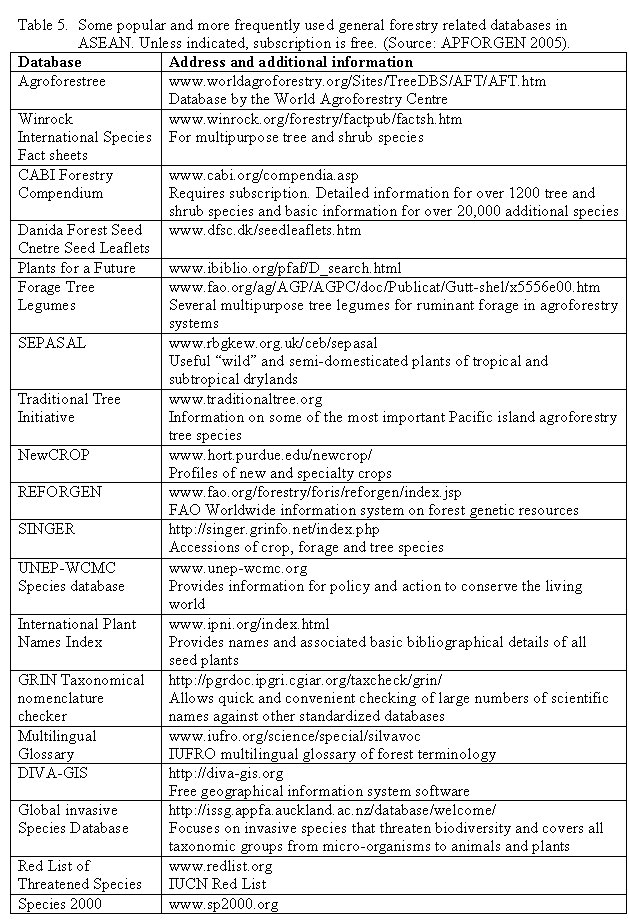| URLs in this document have been updated. Links enclosed in {curly brackets} have been changed. If a replacement link was located, the new URL was added and the link is active; if a new site could not be identified, the broken link was removed. |
Accessing and Sharing Research Information in the ASEAN Region: Malaysia's Perspective
Forest Research Malaysia
52109 Kepong, Selangor, Malaysia
leess@frim.gov.my
Mohamad Zaki Mohd Isa
Forest Research Malaysia
52109 Kepong, Selangor, Malaysia
Abstract
One of the fundamental requirements for conducting research is access to and sharing of information. Traditionally, books and journals were the main sources of reference materials, but over the last decade, the Internet and other sources of electronic information have played an increasingly important role, e.g. the recent advent of APAFRI's E-loan and GFIS-ASIA. Electronic access varies tremendously within the ASEAN region. Researchers in Singapore, Malaysia, Brunei and Thailand have excellent to reasonably good access, but many in other ASEAN countries are not so fortunate. Many researchers may not even have access to a computer. However, even with good electronic access, the availability of appropriate information can vary. For example, university libraries in Malaysia with more generous budgets generally have much wider access than small research institutions, such as FRIM. Similarly, because of budget constraints and economies of scale, developing country research institutions find it difficult to subscribe to many international journals either in print or electronically. Close interaction and personal contact between researchers is one of the most important means of information access and exchange for researchers in developing countries. Senior researchers have the advantage over junior researchers who have yet to develop such extensive contacts.
Introduction
The first step in embarking on any research or in writing an article is to conduct a literature search or review of the topic at hand. Traditionally books, journals and other printed media were the main reference sources, but these materials are becoming increasingly expensive and unaffordable for many scientists and research institutions in developing countries. For example, due to the present poor exchange rate in Malaysia, one would have to pay approximately 50% more today for a similarly priced book in USD compared to five years ago. Moreover, with budget cuts being the norm in many countries, funds for library subscriptions to journals and purchase of literature are drastically reduced. With the exception perhaps of only Singapore, the same holds true for most of the ASEAN nations, which were affected by the 1997 economic slow-down. Researchers in developing countries today have to be more resourceful in finding new ways to access information. The advent of the Internet and other sources of electronic information has been a boon to many scientists, but this too can pose challenges for researchers in some of the less well developed countries where there is limited access to such electronic facilities. In this age of rapidly changing technology, it is a challenge to remain cognizant of the latest findings, developments and innovations. Therefore, access to information is of paramount importance, not only to access the latest data and information, but also to disseminate one's findings.In this paper we would like to share Malaysia's perspective on access and sharing of information in the ASEAN region, with particular focus on Malaysia. ASEAN is the Association of South-East Asian Nations comprising the ten member states of Brunei Darussalam, Cambodia, Indonesia, Lao People's Democratic Republic, Malaysia, Myanmar, Philippines, Singapore, Thailand, and Vietnam. The discussion here is restricted to information pertaining to forestry and forestry-related fields only.
Sources of Forestry-Related Information
Information on forestry and forestry-related fields can be found mainly in the libraries and resource centres of the various universities, which offer forestry courses and in forest-research institutions in the respective ASEAN countries. In Malaysia, the main institutions where forest and forestry-related information can be found are in the libraries of the Forest Research Institute Malaysia (FRIM), Kepong; Universiti Putra Malaysia (UPM); the Forest Research Centre, Sepilok, Sabah; and Universiti Malaysia Sabah (UMS). Literature on wood products research may also be found in the libraries of local institutions of higher learning, which offer courses in wood science and technology such as Universiti Technology MARA (UiTM), Universiti Sains Malaysia (USM) and Universiti Teknologi Malaysia (UTM). A similar situation occurs in neighbouring ASEAN countries, with the larger collections of specialist literature and research material found at institutions that offer forestry and forest-related courses, such as Kasetsart University in Thailand, University of the Philippines at Los Baños, Institut Pertanian Bogor and the University of Gadja Mada in Indonesia, and the Forest Science Institute of Vietnam (FSIV). In addition, a wide range of forest and forestry-related information is available at the Centre for International Forest Research (CIFOR) located at Bogor, Indonesia. Forest and forestry-related information may also be accessed through the {Asia Pacific Association of Forestry Research Institutions} (APAFRI) located at FRIM, Kepong, Malaysia. Smaller collections of more general forestry-related literature may be found in most university libraries in the region, especially those offering courses in biology and related subjects. However, how current the information is varies considerably from one source to another.In a recent survey on scientific publications for the establishment of a Single Point Access Facility (MOSTI 2005) conducted among selected institutions of higher learning and government research institutes in Malaysia, a total of 90,945 records was recorded as being deposited in 13 institutions (Table 1). Text and reference books found in the various libraries were not considered in the survey. More than 55% of the materials recorded in the survey were monographs, working papers, conference and workshop papers while 26% and 18% were post-graduate theses and research/technical papers, respectively. It was noted that the majority of the material, about 78%, had yet to be digitized and a budget of about USD 2 million would be needed for the digitization work. There was no information concerning how many of these publications were related to forestry and forestry-related topics. We are not aware of similar information from other ASEAN member countries.

In addition to the records of scientific publications, the survey also recorded the availability of other sources of information, such as e-journals published by local institutions of higher learning and government research institutes, online international subscriptions to journals and other databases (Table 2). Of the 12 electronic journals published by local institutions, only one can be considered marginally relevant to forestry, i.e. the {Compendium of Medicinal Plants}. The other titles cover the fields of management, medicine and health, natural sciences and ICT. About 12% of the 238 online subscriptions to international journals focus on agriculture and multidisciplinary research, some of which may carry information relevant to forestry research. The majority of the online subscriptions are housed in the universities with a significant number of journals dealing with agriculture housed at the Malaysian Agricultural Research and Development Institute (MARDI). Interestingly, none of the 238 online subscriptions are to forestry and forest-products journals. Perhaps this is not exactly surprising considering the emphasis that the Malaysian government places on agriculture, biotechnology and ICT.

Online subscriptions to international journals are expensive. In Malaysia and South-East Asia, online subscriptions are generally held by large institutional libraries since it is beyond the means of most individuals and libraries with small budgets. Figures for individual online subscriptions to scientific journals are not available, but an idea of the cost and usage of on-line subscriptions by several Malaysian university libraries is shown in Table 3. Among the government research institutions, the Malaysian Agricultural Research and Development Institute (MARDI), which had a budget of about USD 132,000 for their library, spent about USD 40,000 for online subscriptions to nine titles in 2004. In comparison, FRIM's limited budget of approximately USD 68,000 for 2004 was spent almost entirely on subscriptions to 80 printed journals. In view of the high cost of online subscriptions, it is not surprising that libraries in many of the less wealthy and less developed ASEAN member countries are unable to afford such subscriptions or subscriptions to printed journals. In Malaysia, researchers from institutions such as FRIM, which do not maintain online subscriptions, can access the online subscriptions of the various universities' and government research institutions' libraries through special arrangements provided by an agreement reached among the institutions.

Electronic databases are a boon to those with access to the Internet. In ASEAN the APFORGEN (Asia Pacific Forest Genetic Resources Programme) {web site} is an important resource for forestry researchers. APFORGEN is a programme aimed at increasing conservation and sustainable use of tropical forest genetic resources in the Asia-Pacific Region. Its publications are downloadable at no cost and through its "Literature Links," the web site allows users to browse a wide range of publications carried by other organizations, mostly downloadable at no charge. All one needs is access to a computer with a connection to the Internet. Among the publications available on or through the APFORGEN web site are forest and landscape and DFSC (Danida Forest Seed Centre) publications, the FAO (Food and Agriculture Organization of the United Nations) document depository, publications on forest reproductive material, ITTO (International Tropical Timber Organization) resources, and the IPGRI (International Plant Genetic Resources Institute) publications page.
The {forestry databases} of the Food and Agriculture Organization (FAO) of the United Nations have for a long time provided access to a wide range of forestry-related information from all over the world. This resource is now complemented by GFIS or the Global Forest Information Service of IUFRO, which claims to be the gateway to "all" forestry information. GFIS is a metadatabase, providing information to where forest and forestry-related information may be obtained, and is expected to become increasingly popular as a source of forestry information among researchers as more become aware of its capabilities. A wide range of tree species databases and fact sheets are also available online and a small sample of the more popular and commonly used ones is listed in Table 5.

Problems
Gaining full access to the wide number and huge range of forestry-related journals is beyond the means of most scientists in ASEAN countries, due mainly to the high cost of obtaining the materials either by direct purchase or by subscription. Even before the 1997 financial crisis, which hit economies in the ASEAN region, budgets for research materials, especially literature, had been quite small. In the aftermath of the 1997 crisis, exchange rates for many currencies in the region plummeted and, coupled with further budget cuts, it became even more difficult to obtain funds for purchase of and subscriptions to literature, reference materials and other information.Even with the advent of the Internet and easy access to online information, not all scientists in the ASEAN region have easy access to computers and Internet access. We do not have data for all the ASEAN member nations but even in the relatively more well developed ASEAN member nations of Malaysia and Thailand (Singapore is considered a developed nation), the number of personal computers and Internet access is still low compared with the developed countries of Japan and Korea (Table 4). However, when considering institutes of higher learning and government research institutions in Malaysia and Thailand, these figures are generally much higher. For example, at FRIM the ratio of computers to researchers is 1:1 and all computers are linked to the Internet. This situation, however, is unlikely in some of the less well developed ASEAN countries such as Myanmmar, Vietnam, Laos and Cambodia.

Even with good Internet access and connectivity, download speed can be a problem. A survey of libraries in institutions of higher learning and government research institutions in Malaysia revealed that one of the main problems encountered was the length of time taken to download the full text of an article or paper (MOSTI 2005). Another problem encountered with online access sometimes is the requirement for a password from a journal already subscribed to that could be due to third party rules.
Many ASEAN researchers do not possess the necessary language skills for effective searching and exchange of information. Most of the available literature is in English, but English is not widely spoken in many ASEAN countries with the exception of a few like Singapore, Malaysia and Brunei. Searches are based on the use of keywords, but if a scientist is not fluent in English, his or her knowledge of other synonyms or related keywords might be limited, thereby limiting the possibilities for a successful search outcome. Similarly, lack of fluency in English can also be an impediment for effective exchange and sharing of information. Dissemination of information through publications, and at conferences or seminars might also be problematic.
It is surprisingly difficult for ASEAN forestry researchers to access forest and forestry-related information from their neighbouring countries. Many publications are published in native ASEAN languages, e.g. Thai, Bahasa Indonesia, Vietnamese, and there is no common local language among the ten ASEAN nations apart from English. The problem is compounded by local researchers publishing their results and findings in local and internal reports or in the grey literature, which is not easily accessible to researchers outside the country.
Also, many ASEAN forestry researchers are not fully aware of the many information sources available. While some sources of forest and forestry-related information and databases are well-known, such as those accessed through CIFOR, IUFRO, and FAO, there are other less well-known or publicized databases, which are maintained by libraries in local forestry research institutions. For example, FRIM maintains several databases such as the Landscape Plant Database, Medicinal Plant Database, Rattan Information Centre, e-nature Education, Tree Flora and others which can be found at the FRIM web site at www.frim.gov. Most of these databases are accessible without any charge although a small subscription fee may be required for full access.
Networking
The importance of networking cannot be over emphasized as an effective means of access to and sharing of research information in ASEAN. Very often research information is obtained, exchanged and/or shared through the close interaction and personal contacts developed between researchers through the many scientific meetings, conferences and seminars held in the region and elsewhere. Generally senior researchers have the advantage over junior researchers who have yet to develop extensive contacts. The former have more opportunities to attend meetings and conferences and are also more experienced and knowledgeable. A mentoring system may also be effective in allowing young researchers to learn and benefit from more senior and experienced scientists both locally and abroad and also to help them extend their contacts.Another popular means for information exchange and sharing are mailing lists that can be set up according to demand. However, maintenance of a mailing list requires the services of a dedicated web moderator and regular users to keep the mailing list active and relevant.
Networks such as APAFRI and IUFRO play an important role linking researchers through regular newsletters, information updates, training courses, meetings and conferences. APAFRI is an independent non-profit body, aimed at enhancing research and technology development capabilities in support of conservation and management of forest resources in the region. One of its objectives is to develop a more self-reliant and sustainable mechanism to strengthen research networking. APAFRI also offers an E-loan facility, which provides access to the extensive collections in participating libraries for a small fee. This facility promotes free exchange of information, literature and research results across the region and beyond. Currently, the E-loan system has four main participating libraries with collections totaling 1.5 million articles from over 200 international and national journals.
For better access and research information sharing among forestry researchers in the region, coordination and communication also needs to be improved. The Indonesian government has noted that despite CIFOR's attention to strategic research issues conducted in, or of relevance to Indonesian forests, there is a perception among Indonesian national institutions that there has been a failure to capture the full benefits of CIFOR's research. This may also be said to apply to other ASEAN member countries.
Conclusion
In view of the high and increasing cost of research information, as well as difficulty accessing some information, a more concerted effort needs to be made for improved sharing of research information in ASEAN. Improved communication and better networking between researchers and libraries among the various institutions and countries in the region would be one of the most effective means of accessing and sharing research information. Information sharing can also be facilitated by mutual exchange of publications between institutions and through shared access to facilities. Greater publicity also needs to be given to the many and varied sources of research information available, especially those that are available at no cost, so that more researchers become aware and make use of them. Organizations such as APAFRI, IUFRO and FAO continue to play important roles in facilitating such networks. It is hoped that as more researchers become aware of these networks and sources of research information, there will be improved sharing and dissemination of research information not only within the ASEAN region but worldwide.References
APFORGEN. 2005. [Online}. Available: {http://www.apforgen.org/} [May 18, 2006].Meeting of the Sub-Committee on Commercial Databases. 2005. UKM Library, 24 January 2005.
MOSTI. 2005. Ministry of Science, Technology and Innovations. Mesyuarat kerjasama pembangunan SPAF bagi penerbitan saintifik tempatan. (Cooperation meeting for the development of SPAF for local scientific publications). 31 May 2005, Putrajaya, Malaysia.
PIKOM. 2005. Status of the industry report. PIKOM Industry Dialogue 2005, Eastin Hotel, Petaling Jaya, 14 June 2005. Association of the Computer and Multimedia Industry of Malaysia.
| Previous | Contents | Next |
